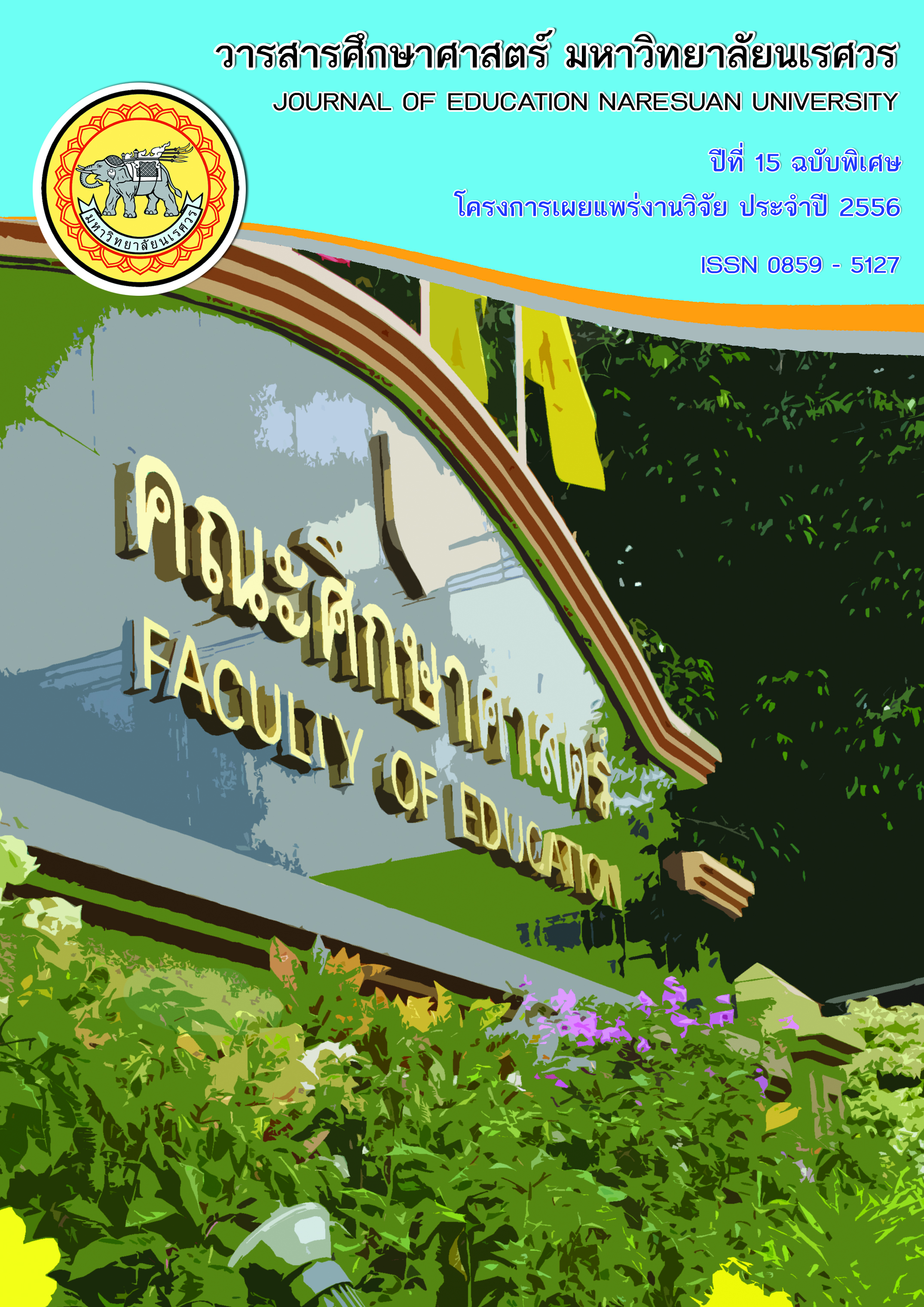รูปแบบการจัดการศึกษาทางเลือกสำหรับเด็กด้อยโอกาสทางการศึกษา ในเขตพื้นที่สูงภาคเหนือตอนบนของประเทศไทย
Main Article Content
Abstract
บทคัดย่อ
การวิจัยนี้เป็นการวิจัยแบบผสมผสานของการวิจัยเชิงคุณภาพและการวิจัยเชิงปริมาณโดยมีวัตถุประสงค์เพื่อพัฒนารูปแบบการจัดการศึกษาทางเลือกสำหรับเด็กด้อยโอกาสทางการศึกษาในพื้นที่สูงภาคเหนือตอนบน วิธีดำเนินการวิจัยมี 3 ขั้นตอนคือ 1) การศึกษาสภาพปัญหาและความต้องการในการจัดการศึกษาทางเลือกสำหรับเด็กด้อยโอกาสทางการศึกษาในพื้นที่สูงภาคเหนือตอนบนโดยการสัมภาษณ์ ผู้ปกครองและนักเรียนที่ออกกลางคัน วิเคราะห์และสังเคราะห์ เอกสาร และงานวิจัยที่เกี่ยวข้อง การวิเคราะห์ข้อมูลใช้การวิเคราะห์เนื้อหา 2)การสร้างรูปแบบการบริหารสถานศึกษาขั้นพื้นฐานบนพื้นที่สูงและทุรกันดาร โดยนำข้อมูลจากขั้นตอนที่ 1 และทฤษฎีมายกร่างรูปแบบการจัดการศึกษาทางเลือกสำหรับเด็กด้อยโอกาสทางการศึกษาในพื้นที่สูงภาคเหนือตอนบนและตรวจสอบความเหมาะสมของรูปแบบฯด้วยการสัมมนาผู้เชี่ยวชาญ (Connoisseurship Seminar)จำนวน 7 คนและ 3) การประเมินความเป็นไปได้ความมีประโยชน์ความเหมาะสมในการนำไปใช้และความคุ้มค่าในการลงทุนของรูปแบบรูปแบบการจัดการศึกษาทางเลือกสำหรับเด็กด้อยโอกาสทางการศึกษาในพื้นที่สูงภาคเหนือตอนบน โดยใช้แบบสอบถามและสัมภาษณ์อย่างไม่เป็นทางการกับผู้บริหารการศึกษา ผู้บริหารสถานศึกษาและครูวิชาการในสถานศึกษาขั้นพื้นฐานบนพื้นที่สูงจำนวน 60 คน
ผลการวิจัยพบว่า
1. สภาพปัญหาสำคัญของการจัดการศึกษาทางเลือกสำหรับเด็กด้อยโอกาสในเขตพื้นที่สูงภาคเหนือตอนบนของประเทศไทยประกอบด้วย 1) ด้านนักเรียน : ครอบครัวมีฐานยากจนและไม่สนับสนุนให้ลูกได้รับการศึกษา ภาษาเป็นอุปสรรคในการเรียน และเด็กพักอยู่ห่างไกลจากโรงเรียน 2) ด้านโรงเรียน : หลักสูตรไม่เหมาะสมโรงเรียนตั้งอยู่ในที่ห่างไกลจากที่พักของนักเรียนครูขาดความเข้าใจในตัวนักเรียน
2. ความต้องการที่สำคัญของนักเรียนและผู้ปกครองได้แก่ในแต่ละชุมชนมีศูนย์การเรียนย่อยและมีครูประจำเพื่อสะดวกในการเรียน หลักสูตรมีความยืดหยุ่นสอนเฉพาะวิชาที่จะเป็นและใช้ประโยชน์ได้ในชีวิตประจำวันเนื้อหาวิชาควรเน้นวิชาชีพเป็นสำคัญ
3. รูปแบบการจัดการศึกษาทางเลือกสำหรับเด็กด้อยโอกาสทางการศึกษาในพื้นที่สูงภาคเหนือตอนบนที่สร้างขึ้นมีวัตถุประสงค์เพื่อพัฒนานักเรียนที่ออกกลางคัน และกลุ่มที่ไม่จบการศึกษาภาคบังคับ หรือผู้สนใจ อย่างต่อเนื่อง เป็นศูนย์การเรียนรู้ที่สามารถนำไปเกาะเกี่ยวกับโรงเรียนปกติแต่ใช้เวลานอกราชการเป็นไปตามหลักการของทฤษฎีระบบประกอบด้วยปัจจัยนำเข้าที่เกี่ยวข้องกับงานบุคลากร งานวิชาการ และงานบริหารทั่วไป กระบวนการเกี่ยวข้องกับ กระบวนการบริหารงานวิชาการ และบริหารงานทั่วไปโดยใช้แรงจูงใจในการขับเคลื่อนผลผลิตเกี่ยวข้องกับโอกาสทางการเรียนของนักเรียนที่สามารถเรียนจบการศึกษาภาคบังคับและประกอบอาชีพเลี้ยงครอบครัวได้และบริบทเกี่ยวข้องกับนโยบายการจัดการศึกษาทางเลือกบนพื้นที่สูง การพัฒนาทรัพยากรบุคคลการใช้ครูภูมิปัญญาท้องถิ่นคู่กับครูปกติ
4. รูปแบบการจัดการศึกษาทางเลือกสำหรับเด็กด้อยโอกาสทางการศึกษาในเขตพื้นที่สูงภาคเหนือตอนบนของประเทศไทยที่พัฒนาขึ้นเป็นรูปแบบที่มีความเป็นไปได้และมีความคุ้มค่าในระดับมากโดยมีความเหมาะสมและความมีประโยชน์อยู่ในระดับมากที่สุด
คำสำคัญ : การศึกษาทางเลือก/ เด็กด้อยโอกาสทางการศึกษา
Abstract
This study was a combination of qualitative research and quantitative research. The objective was to develop alternative model of education for disadvantage children living on highlands of the upper Northern Region. The methodology included three steps: 1) A study of the problems and needs of alternative education for disadvantage children on the highlands by interviewing parents and dropped-out students, analyzing and synthesizing related researches and documents. Data were analyzed by content analysis method. 2) Creating a basic educational management pattern on highlands by using the information from Step 1 to draft an alternative education model for disadvantage children and to determine the appropriateness of the model by organizing a connoisseurshipseminar of seven experts, and 3) assessing the feasibility, usefulness of the application, and value of the investment of an alternative educational model for disadvantage children on highlands by organizing a conference in order to listen to the opinions of 60 educational administrators, school administrators and teachers on highlands.
Results indicated as follows
1. The academic problems in educational management for disadvantage children on highlands appeared as follows; first, in terms of students, their families lived in poverty and they did not support their children to further their education. The students also lived far away from schools. Second, in terms of schools, the curriculum was not suitable for schools located far away from the students. The teachers lacked understanding their students.
2. The most important needs of students and guardians in each community were to have sub-educational centers and full-time teachers in order to student comfortably. The curriculum should be flexible, useful and necessary to use in real life. Vocational contents should be emphasized.
3. An alternative education model for disadvantage children on highlands is the process that can be interlaced with regular schools beyond the government office hours, followed the theory of the input factors related to working environment—personnel, academic and general administration, and other processes related to administration by using motivation to drive the output of the opportunities of the students who could graduate the compulsory education and work to feed their families, as well as the contexts of alternative education management on highlands policy, human resource management, and the use of local wisdom teachers.
4. The developed Alternative Education Management Model for Disadvantaged Children on Highlands in the Upper North, Thailand, had high feasibility and value at a very high level while the suitability and usefulness were at the highest level.
Key words: Alternative Education/ Disadvantaged Children
Article Details
The owner of the article does not copy or violate any of its copyright. If any copyright infringement occurs or prosecution, in any case, the Editorial Board is not involved in all the rights to the owner of the article to be performed.


